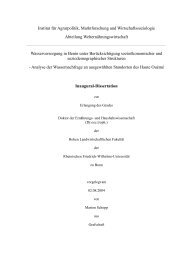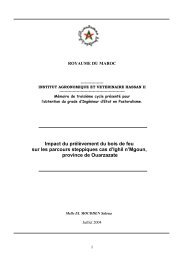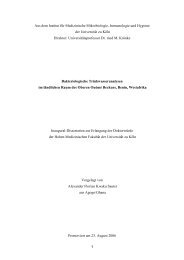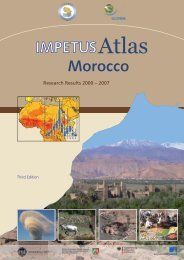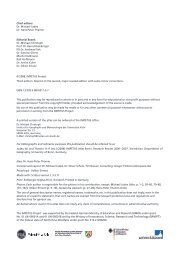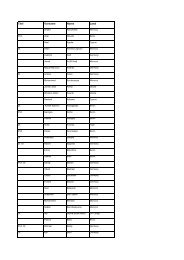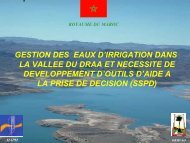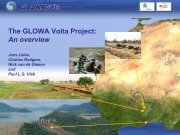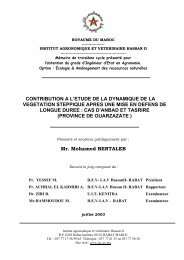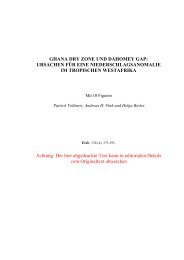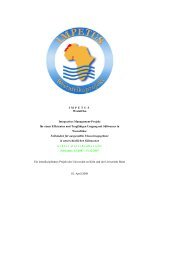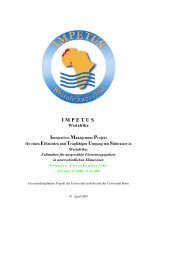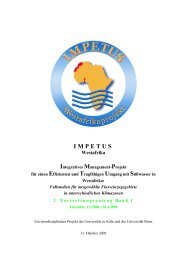- Page 1 and 2: IMPETUSWest AfricaAn Integrated App
- Page 3 and 4: IMPETUSInhaltsverzeichnis / Content
- Page 5: IMPETUSB5 Soziokultureller Wandel u
- Page 9 and 10: Zusammenfassung IMPETUS 3gigkeit 19
- Page 11 and 12: Introduction IMPETUS 5I. Einleitung
- Page 13 and 14: Introduction IMPETUS 7mestic consum
- Page 15 and 16: Development of scenarios IMPETUS 9I
- Page 17 and 18: Development of scenarios IMPETUS 11
- Page 19 and 20: Development of scenarios IMPETUS 13
- Page 21 and 22: Development of scenarios IMPETUS 15
- Page 23 and 24: Development of scenarios IMPETUS 17
- Page 25 and 26: Development of scenarios IMPETUS 19
- Page 27 and 28: Development of scenarios IMPETUS 21
- Page 29 and 30: Development of scenarios IMPETUS 23
- Page 31 and 32: Development of scenarios IMPETUS 25
- Page 33 and 34: Development of scenarios IMPETUS 27
- Page 35: Development of scenarios IMPETUS 29
- Page 39 and 40: Development of scenarios IMPETUS 33
- Page 41 and 42: Development of scenarios IMPETUS 35
- Page 43 and 44: Development of scenarios IMPETUS 37
- Page 45 and 46: Development of scenarios IMPETUS 39
- Page 47: Development of scenarios IMPETUS 41
- Page 50 and 51: 44IMPETUS Problem clustersCoupling
- Page 52 and 53: 46IMPETUS Problem clustersFood secu
- Page 54 and 55: 48IMPETUS Problem clustersstates of
- Page 56 and 57: 50IMPETUS Problem clustersTab. III.
- Page 58 and 59: 52IMPETUS Problem clusters• In th
- Page 61 and 62: Capacity Building IMPETUS 55IVCapac
- Page 63 and 64: Capacity Building IMPETUS 57Tab. IV
- Page 65 and 66: Capacity Building IMPETUS 59Tchaour
- Page 67 and 68: Capacity Building IMPETUS 61• app
- Page 69 and 70: Publications IMPETUS 63Giertz, S. &
- Page 71: Publications IMPETUS 65Veste, M. &
- Page 75 and 76: Subproject AB1 IMPETUS 69Teilprojek
- Page 77 and 78: Subproject AB1 IMPETUS 71could be i
- Page 79 and 80: Subproject AB1 IMPETUS 730.400.300.
- Page 81 and 82: Subproject AB1 IMPETUS 75250200150u
- Page 83 and 84: Subproject AB1 IMPETUS 77Workpackag
- Page 85 and 86: Subproject AB1 IMPETUS 79At the beg
- Page 87 and 88:
Subproject AB1 IMPETUS 81In some re
- Page 89 and 90:
Subproject AB1 IMPETUS 83Fig. AB1-1
- Page 91 and 92:
Subproject AB1 IMPETUS 85Fig. AB1-1
- Page 93 and 94:
Subproject AB1 IMPETUS 87May 2006.
- Page 95:
Subproject AB1 IMPETUS 89Roeckner,
- Page 98 and 99:
92IMPETUS Subproject A1Dabei sind d
- Page 100 and 101:
94IMPETUS Subproject A1Workpackage
- Page 102 and 103:
96IMPETUS Subproject A1estation and
- Page 104 and 105:
98IMPETUS Subproject A1Another prob
- Page 106 and 107:
100IMPETUS Subproject A1particular
- Page 108 and 109:
102IMPETUS Subproject A1The reclass
- Page 110 and 111:
104IMPETUS Subproject A1a) b)c) d)
- Page 112 and 113:
106IMPETUS Subproject A1Central and
- Page 114 and 115:
108IMPETUS Subproject A2des Sedimen
- Page 116 and 117:
110IMPETUS Subproject A2Workpackage
- Page 118 and 119:
112IMPETUS Subproject A2Workpackage
- Page 120 and 121:
114IMPETUS Subproject A2Fig. A2-3 s
- Page 122 and 123:
116IMPETUS Subproject A2MethodThe m
- Page 124 and 125:
118IMPETUS Subproject A220002025Ero
- Page 126 and 127:
120IMPETUS Subproject A2and rivers,
- Page 128 and 129:
122IMPETUS Subproject A2(Schopp 200
- Page 131 and 132:
Subproject A3 IMPETUS 125Teilprojek
- Page 133 and 134:
Subproject A3 IMPETUS 127suchungen
- Page 135 and 136:
Subproject A3 IMPETUS 129the model
- Page 137 and 138:
Subproject A3 IMPETUS 131tween 0.69
- Page 139 and 140:
Subproject A3 IMPETUS 133global sca
- Page 141 and 142:
Subproject A3 IMPETUS 135A 3-2: Ana
- Page 143 and 144:
Subproject A3 IMPETUS 137Natural mo
- Page 145 and 146:
Subproject A3 IMPETUS 139Tree regen
- Page 147 and 148:
Subproject A3 IMPETUS 141each field
- Page 149 and 150:
Subproject A3 IMPETUS 143underestim
- Page 151 and 152:
Subproject A3 IMPETUS 145ment accor
- Page 153:
Subproject A3 IMPETUS 147Literature
- Page 156 and 157:
150IMPETUS Subproject A4tersuchungs
- Page 158 and 159:
152IMPETUS Subproject A4water consu
- Page 160 and 161:
154IMPETUS Subproject A4Tap waterTa
- Page 162 and 163:
156IMPETUS Subproject A4These resul
- Page 164 and 165:
158IMPETUS Subproject A4Tab. A4.1:E
- Page 166 and 167:
160IMPETUS Subproject A4The most re
- Page 168 and 169:
162IMPETUS Subproject A4Workpackage
- Page 170 and 171:
164IMPETUS Subproject A4Results of
- Page 172 and 173:
166IMPETUS Subproject A4livestock m
- Page 175 and 176:
Subproject A5 IMPETUS 169Teilprojek
- Page 177 and 178:
Subproject A5 IMPETUS 171Meningitis
- Page 179 and 180:
Subproject A5 IMPETUS 173emissions,
- Page 181 and 182:
Subproject A5 IMPETUS 175DonorsPoli
- Page 183 and 184:
Subproject A5 IMPETUS 177worth of e
- Page 185 and 186:
Subproject A5 IMPETUS 179equally in
- Page 187 and 188:
Subproject A5 IMPETUS 181cal and ch
- Page 189 and 190:
Subproject A5 IMPETUS 183quantitati
- Page 191 and 192:
Subproject A5 IMPETUS 185The nearly
- Page 193:
Part B IMPETUS 187Projektbereich BD
- Page 196 and 197:
190IMPETUS Subproject AB1angetriebe
- Page 199 and 200:
Subproject B1 IMPETUS 193Teilprojek
- Page 201 and 202:
Subproject B1 IMPETUS 195Workpackag
- Page 203 and 204:
Subproject B1 IMPETUS 197rainfall s
- Page 205 and 206:
Subproject B1 IMPETUS 199Fig. B1-4:
- Page 207 and 208:
Subproject B1 IMPETUS 201Two climat
- Page 209 and 210:
Subproject B1 IMPETUS 203Fig. B1-9:
- Page 211:
Subproject B1 IMPETUS 205sodes puts
- Page 214 and 215:
208IMPETUS Subproject B2Szenarienre
- Page 216 and 217:
210IMPETUS Subproject B2Workpackage
- Page 218 and 219:
212IMPETUS Subproject B2teristics a
- Page 220 and 221:
214IMPETUS Subproject B2Periods of
- Page 222 and 223:
216IMPETUS Subproject B2stations an
- Page 224 and 225:
218IMPETUS Subproject B2B2-8 shows
- Page 226 and 227:
220IMPETUS Subproject B2considered
- Page 228 and 229:
222IMPETUS Subproject B2terdiscipli
- Page 230 and 231:
224IMPETUS Subproject B2Fig. B2-13:
- Page 232 and 233:
226IMPETUS Subproject B2Direction d
- Page 234 and 235:
228IMPETUS Subproject B3• Agricul
- Page 236 and 237:
230IMPETUS Subproject B3Development
- Page 238 and 239:
232IMPETUS Subproject B3Vegetation
- Page 240 and 241:
234IMPETUS Subproject B3Fig. B3-6:B
- Page 242 and 243:
236IMPETUS Subproject B3Fig. B3-8:T
- Page 244 and 245:
238IMPETUS Subproject B3by a paired
- Page 246 and 247:
240IMPETUS Subproject B3abcdFig. B3
- Page 249 and 250:
Subproject B4 IMPETUS 243Teilprojek
- Page 251 and 252:
Subproject B4 IMPETUS 245• Includ
- Page 253 and 254:
Subproject B4 IMPETUS 247Tab. B4.1:
- Page 255 and 256:
Subproject B4 IMPETUS 249With pumpi
- Page 257:
Subproject B4 IMPETUS 251Heidecke,
- Page 260 and 261:
254IMPETUS Subproject B5verursachte
- Page 262 and 263:
256IMPETUS Subproject B5are met wit
- Page 264 and 265:
258IMPETUS Subproject B5Ameskar Fou
- Page 266 and 267:
260IMPETUS Subproject B540,0Number
- Page 268 and 269:
262IMPETUS Subproject B5The results
- Page 270 and 271:
264IMPETUS Subproject B5level. The
- Page 272 and 273:
266IMPETUS Subproject B5• Busines
- Page 275 and 276:
Subproject C2 IMPETUS 269Teilprojek
- Page 277 and 278:
Subproject C2 IMPETUS 271prietary I
- Page 279 and 280:
Subproject C2 IMPETUS 273The centra
- Page 281 and 282:
Subproject C2 IMPETUS 275ing basic
- Page 283 and 284:
IMPETUS Atlases IMPETUS 277Fig. VII
- Page 285 and 286:
IMPETUS Atlases IMPETUS 279Fig. VII



